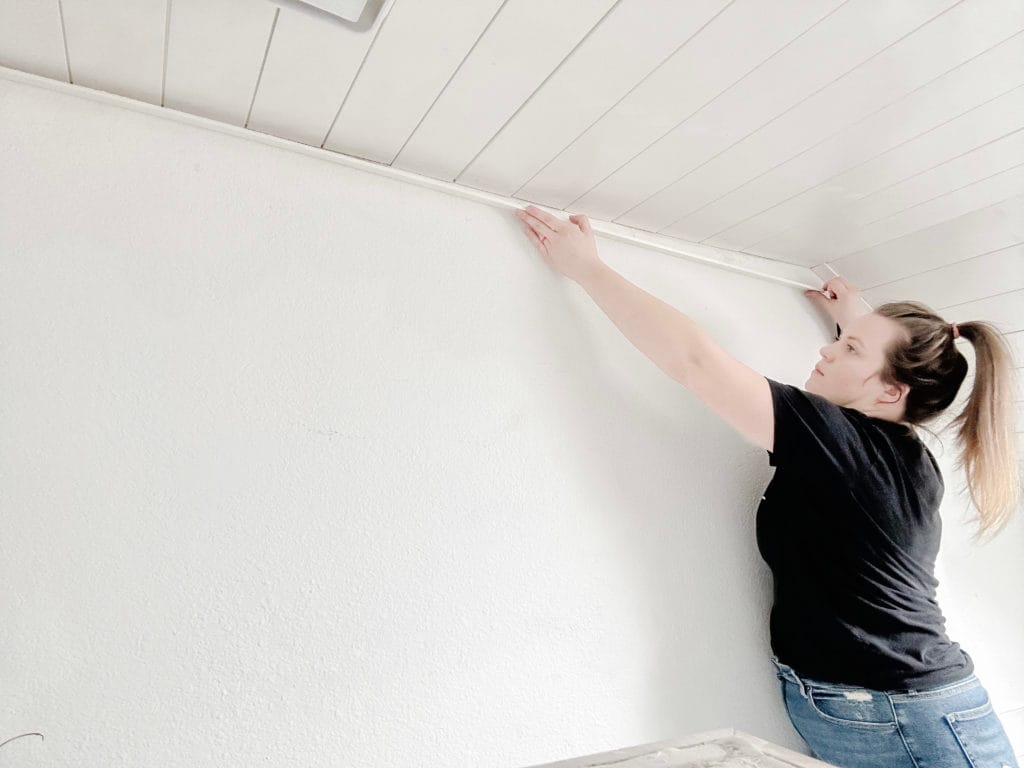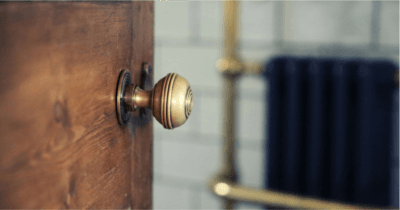Some homes ooze charm. Others need some help to get there. Today I’m sharing the step-by-step process of installing a shiplap bathroom ceiling in our green primary bathroom! Instantly adding so much classic character to this space.

- Tools & Materials Needed
- DIY Shiplap Bathroom Ceiling Installation Instructions
- Step 1. Plan Your Shiplap Bathroom Ceiling Design
- Step 2. Prepare Shiplap for Painting
- Step 3. Choose The Starting Point
- Step 4. Mark The Studs With a Pen
- Step 5. Remove All Fixtures
- Step 6. Measure and Cut Each Shiplap Board
- Step 7. Add Liquid Nails to the Back of Each Board
- Step 8. Nail Shiplap Boards Into Place
- Step 9. Add Trim
- Step 10. Fill In Nail Holes with Wood Filler
- Step 11. Caulk The Edges
- Step 12. Add a Final Paint Coat
- Troubleshooting Special Cuts
- The Finished Shiplap Bathroom Ceiling Look

Tools & Materials Needed
TOOLS
- Ladders or scaffolding (you can rent these from Home Depot)
- Brad Nail Gun
- Jig Saw – for rounded cuts around lights, fans, and corners
- Table Saw – for long cuts
- Sliding Mitre Saw – for small and angled cuts
- Paint Sprayer
- Paint Mask – if spraying
- OR these foam paint rollers and this Zibra paint brush
- Paint Drop Sheets
- Protective Glasses
- Caulk Gun
- Nail Punch
- Nail Gun
MATERIALS
- Shiplap – Pre-Primed
- 2″ 18-Gauge Finish Nails
- Liquid Nails
- Caulk – I used caulk with silicone since it’s being installed in a bathroom
- Paint – I used Behr Marquee Exterior Semi-Gloss
DIY Shiplap Bathroom Ceiling Installation Instructions
Step 1. Plan Your Shiplap Bathroom Ceiling Design
The first step before you begin is choosing a shiplap design. (See the Definitive Guide for Shiplap Design here!)There are lots of options for trim, paint, and decorative additions like beams. Once you have your design in mind, gather all your supplies and block off some time with a partner to get started.
Project Steps Overview
- Plan your ceiling design.
- Prepare shiplap for painting.
- Plan your starting point.
- Mark the studs with a pen.
- Remove light fixtures, fans, vent covers.
- Measure and cut each board.
- Add liquid nails to the back of each board.
- Attach each board to studs with a nail gun.
- Add trim.
- Fill in the nail holes and sand.
- Caulk all the edges.
- Add one final paint coat.

Step 2. Prepare Shiplap for Painting
Good prep and quality paint are two keys to a good paint finish. I’ve used three different painting methods for Shiplap in my home – paint sprayer, roller, and brush – and have had success with each one.
Whichever painting method you choose, I recommend spending extra money to get a premium quality paint. It makes a huge difference in the amount of paint that you need to use, and in the final finish.
How To Prep Shiplap For Paint:
- First, use wood filler to fill in any indents.
- Next, lightly sand smooth with 220 grit sandpaper once dry.
- Then, prime the boards if needed. Mine were pre-primed already.
- Lastly, If you’re painting with a color other than white, paint the grooves and edges now.
Read: Full Step-By-Step Guide for Painting Shiplap
It’s really difficult to paint in between the boards once they’re installed. The gap between boards is very small and it’s almost impossible to fit a brush in it. Painting it now will save you a lot of extra work later!
I used Behr Marquee Exterior Semi-Gloss paint from Home Depot. I chose an exterior, glossy paint because our Shiplap was being installed in a bathroom. Gloss acts as a protectant against dirt and moisture. I’d recommend at least a Satin finish. A semi-gloss is even better. An exterior paint is another measure of protection from steam in a bathroom. (Be sure to check your area’s building codes about using exterior paint inside.)

Step 3. Choose The Starting Point
Start in the spot that makes the most sense for your project. Look at your ceiling and consider what potential snares you might encounter as you lay down your boards. Are there any parts of the ceiling you anticipate will be tricky?
We started in the very middle of the ceiling because we have an angled wall. I wanted to ensure we had one full board on each side of this angle. We didn’t want to do the math to figure out how to hit this angle correctly, and risk needing to trim a board into multiple pieces right in the middle of the ceiling. This made the most sense to us.
Step 4. Mark The Studs With a Pen
Next, use a stud finder and locate all the studs beneath the drywall. It’s very important to nail the shiplap boards into studs as much as possible. These boards are heavy and you don’t want them falling or sagging down.
Nathan drew a straight line over each stud directly onto the drywall so we always knew where to nail each board. For any boards that didn’t have a stud available, we angled the nails slightly to make a cross into the drywall to help it stay attached better and not slip out over time.
It’s not always possible to nail the board into studs, unfortunately. For added security, we ran a thick bead of liquid nails on the back of each board. Then we added multiple nails right next to each other and slightly angled them in opposite directions. This creates a cross hatch that should grip the drywall and prevent it from slipping. As much as possible though, nail the boards into studs.
The direction of the ceiling joists or studs beneath the drywall typically determine which direction your shiplap should be installed. If you want to install them differently, talk with a licensed contractor. They may have solutions for this.

Step 5. Remove All Fixtures
Your shiplap goes underneath all your light fixtures, fans, and vent covers. Make sure you remove all of these before installing your shiplap. This will give you a professional, cleanly layered look.
Step 6. Measure and Cut Each Shiplap Board
We measured, cut, and installed 2-3 boards at a time. This made the project go much faster. We were planning to install trim so we didn’t need to be exact with our measurements.
If you’re choosing to use no trim for a really built-in look, it’s important to measure each board individually. You need to get every edge as close to the wall as possible. There’s very minimal room for error in this method. No wall is perfectly straight, and wrong cuts are expensive.
We used a mitre saw to cut the ends off of each board, and a table saw for any final boards that needed trimmed length-wise. We used a ryobi jig saw for special cuts around lights, vents, and fans as needed.

Step 7. Add Liquid Nails to the Back of Each Board
It wasn’t possible to get nails into studs for every single board. Especially the smaller boards around our skylight. For extra security to ensure the boards would stay up, we added a thick bead of liquid nails down the back of each board right before installing them.
Step 8. Nail Shiplap Boards Into Place
Our boards were 12ft long and required two people on separate ladders to install. We climbed the ladders with one hand, holding the board with liquid nails on it in the other.
We held up the board the ceiling and squished the liquid nails into the drywall.
One person used the nail gun to attach the board to every stud possible using 2″ 18-guage nails. Then we passed the nail gun to the next person to nail in the other side of the board.
Typically, studs are about 16-25″ apart. We needed 2″ nails so that the nails would be long enough to go through the shiplap and drywall, and be securely attached to the studs underneath.
DIY Tip: Sink exposed nail heads with a nail punch.

Step 9. Add Trim
Next, we added our low-profile trim. As you can see, there was some gapping along the edges of the walls between the boards and the edge. Those were totally hidden with trim! Magic. If you’re not using trim, skip straight to the next step.
Step 10. Fill In Nail Holes with Wood Filler
I blocked off a few hours one morning while my kids were in school, streamed some Psych on my computer, and filled each hole with a small amount of wood filler.
The goal is to slightly overfill each hole, but not too much. Once it dried, I used 220 grit sandpaper to sand every hole smooth.
This will make the nail holes look invisible after everything is painting. It might look like a mess now, but I promise it’s about to get a hole lot better. No pun intended.
DIY Tip: Don’t overfill your nail holes with wood filler

Step 11. Caulk The Edges
Next, I caulked all the outside edges between the shiplap ends and the wall. This creates a seamless transition between the walls and the ceiling. It also is important for moisture prevention. You don’t want steam getting behind your boards.
If you’re skipping trim, you can just caulk the edges of the shiplap directly to the wall next to it. For larger gaps, you can use a quality wood filler.
Step 12. Add a Final Paint Coat
Your shiplap bathroom ceiling is almost done! By now, my boards looked like a mess from prepping and installing them. I chose to use my sprayer for one final paint coat since the ceiling is so high. It took a lot of prep to get the room ready, but the finish turned out AMAZING.
By the way, I shared tips for painting shiplap with a paint sprayer in this post.

Troubleshooting Special Cuts
Nathan is way better at math. I’m so grateful that he was in charge of all measurements for this project. Or it would have turned out very differently. He (“magically”) figured out the placement for each cut around light fixtures and vents.

He measured and marked the back of the boards for the main cut. Then used our ryobi jig saw to cut as needed around fixtures. My contribution was finding a vase that was the exact size of the light hole we needed, so we could just trace the circle shape. You’re welcome, Nathan!

Nathan cut away each piece and then we dry fit fixtures to make sure they would work. Then we installed it just like every other piece – a bead of liquid nails, and nailed into studs.
The Finished Shiplap Bathroom Ceiling Look
We are so in love with how it turned out. It’s been over a month since we completed this shiplap bathroom ceiling project. The paint finish and installation has held up great! We still love the style of it and have no regrets.


We thought we could finish this project in one weekend. It ended up taking two. Between managing our kids, and a few roadblocks, we needed the extra time. We got delayed by a few days because our original shipment of Shiplap was poor quality and had to be returned.
We also didn’t order any extra boards, made a few wrong cuts, and ran out of boards right before we finished. I had to get the paint sprayer back out again and it took some extra time to finally finish. That’s how DIY’s go, though, right? It’s always *something* that makes it take a little longer. Oh well!
I hope this DIY Shiplap Bathroom Ceiling tutorial is helpful for your DIY home journey. What questions do you have about this process? I’ll answer them below!
Read Next…
Complete Guide To Painting Shiplap






